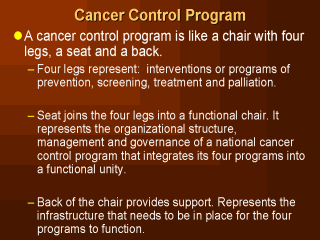 |
For any program success, strong management
and support for program strategies at all levels of the health care system are essential.
Crucial to gaining this support is to clearly demonstrate the need and demand for a
cervical cancer control program. Demonstration should include analyses of the estimated
costs and impact of various program approaches. Health care providers and clients should
be involved in program design to ensure that their perspectives are considered and their
needs are met. Potential bottlenecks to program functioning (for example, logistical
barriers) should be identified and addressed at the start. Finally, effective programs
rely on health care providers trained to be sensitive to client concerns and needs. |
